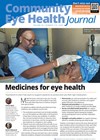In the second in the series about community eye care in the home nations, Janet Pooley explains how Scotland has developed its services within GOS.
The United Kingdom has devolved healthcare; the powers were transferred from Westminster to Scotland and Wales on 1 July 1999, and to Northern Ireland on 2 December 1999. Since then, there has been increasing policy divergence between the health systems of the four nations [1]. Reportedly described by the CEO of the Association of Optometrists in Ireland as “the holy grail of eye care,” [2] Scotland has invested heavily in developing and enhancing community eye care. There are dramatic differences in the service north of the border, not least in the provision of free NHS funded eye examinations to everyone.Such differences are clear when General Ophthalmic Services (GOS) regulations are compared.
The development of GOS
Elsewhere in the UK the eye test, provided as GOS, has been left largely unaltered. Enhanced services, e.g. Minor Eye Conditions Services (MECS), and local integrated pathways, e.g. glaucoma repeat readings and ocular hypertension (OHT) monitoring, form a ‘bolt-on’ to the basic provision [3]. Scotland took the step of developing the service as a whole. The ‘eye test’ became the ‘eye examination’ and was funded by the NHS in 2006 for everyone [4]. The routine use of a binocular indirect retinal examination, comprehensive field testing and Goldmann tonometry, formed the basis of the enhanced provision. This also included dilated examinations for patients aged over 60 years, and retinal photography as standard for these patients.
For the first time, the service provided a supplementary examination that facilitated an additional appointment. This allows the optometrist to recall patients to repeat tests and procedures, and to review the patient in-between routine appointments. It supports the management and care of eye conditions within community practice under GOS. The enhanced supplementary examination that has just recently been introduced [5], provides additional funding when the review appointment requires the patient to be dilated. These examinations take longer and the new fee reflects the additional time.
“Developing optometrists to manage more of the non-sight threatening conditions within the community seems an obvious step to building a sustainable service.”
With the service being free for the patient and therefore no financial barriers to care, GPs have been able to sign-post all patients with concerns about their eyes to optometry – the service is the ‘first port of call’ for any patient with an ophthalmic problem. In this way, optometry is providing huge amounts of support to our GP colleagues who are facing the increasing pressure of higher workloads and workforce challenges [6].
The enhanced service has allowed and facilitated the optometrists to become the gatekeepers to the hospital eye service, managing sight-limiting conditions until they require specialist care in the hospital eye service. Referrals are then made electronically in most case, directly to the hospital, allowing retinal photographs and other relevant information to be attached to the referral.
Training to support high quality care
All the services within GOS are provided by all the listed optometrists and ophthalmic medical practitioners (OMPs). There is not the option to opt-out of part of the provision. It may be that some practitioners are working at a higher level of competence, e.g. independant prescribing (IP) optometrists, but everyone is expected to provide the full range of services. If a practitioner is finding an area of practice challenging, or indeed if the level of care provided is causing concerns, then additional training can be provided. Often on a one to one basis, and tailored to the individual, this can help to ensure that the quality of care remains high.
When the new regulations were introduced in 2006, the NHS with support from the profession, took the unique opportunity to benchmark all practitioners on a set of basic competencies. Most notably, the routine use of the slit-lamp, condensing lenses and contact tonometry were assessed to ensure this baseline. Further training was also provided on the interpretation of visual fields.
If a practitioner is out of the service for more than two years, further training is required to ensure maintenance of these skills. This training is also required should an optometrist or OMP from outside Scotland wish to be listed to provide GOS. Although it should be noted that this baseline is within the General Optical Council (GOC) competencies for all registered optometrists.
As part of the continual development of the service, funding from the Scottish Government for CPD is provided through NHS Education for Scotland (NES). This Special Health Board provides training to staff across the healthcare workforce, and optometry’s position within NES continues to ensure that optometrists receive on-going training. Key to this has been the Teach and Treat Clinics; hospital based clinics that allow community optometrists to gain experience of managing and caring for patients under the supervision of a consultant ophthalmologist. The clinics give time for optometrists to discuss differential diagnosis, treatment options and case management. The medical teaching staff, ophthalmic nurses and clinic receptionists are fundamental to the smooth running of these training clinics, and have been incredibly supportive of the project. It is their hard work and enthusiasm that has made the project such a success.
Independent prescribers
Traditionally the optometrist managed the refractive elements of a patient’s vision and referred on any pathology of the eye or general health concerns. With a dramatically ageing population and advances in the treatments available, there is no longer capacity for secondary care to manage this level of referral and more care needs to be provided out in the community. GP services are also under considerable strain [6]. Developing optometrists to manage more of the non-sight threatening conditions within the community and support sight-limiting disease until such time as the patient requires surgery seems an obvious step to building a sustainable service and this means that there is a huge opportunity for optometrists to utilise their skills in disease management.
NHS Scotland and individual optometrists have invested heavily in IP. The qualification is divided into several parts including university taught and accredited modules provided by Glasgow Caledonian University in Scotland, 24 hospital based sessions with a consultant ophthalmologist and a professional examination set by the College of Optometrists. Once qualified, the practitioner is able to apply for an NHS prescribing pad; there are no prescription charges in Scotland.
As is well understood by our medical colleagues, prescribing and treating ocular conditions requires experience and confidence. Support mechanisms to aid colleagues have developed around Scotland and there are on-going peer support groups. NES provides further training and an annual prescribing conference grows bigger each year. There is also support within some NHS Boards from pharmacy colleagues to monitor prescribing and support adherence to the formulary. Scotland now has over 250 IP community optometrists.
Even without IP, all optometrists prescribe and local patient group directions (PGDs) or prescribing pathways have been established to ensure that there is access to the medication that a patient requires. An app to support the management of ocular conditions in the community has been developed for optometrists in Scotland and is free to download [7]. Utilising the guidelines established by the College of Optometrists, NHS Grampian had been developing guidance since their Eye Heath Network started in 2007 [8]. These were transformed with support from the Scottish Government, and additional input from colleagues in NHS Forth Valley. The use of the app has been endorsed across all the NHS Boards and it ensures easy access to the guidance.
The optometrist has a key role in supporting patients to self-manage their on-going ocular conditions. Chronic conditions such as dry eye and blepharitis can be very challenging for older patients and having time to explain to patients how they should be looking after their eyes can have huge benefits.
The community eye care services review
In 2017 the Scottish Government undertook a review of the whole of the community eye care service [9]. Various recommendations to develop and enhance the service were made and have formed the basis of the policy direction for the Government’s optometry team. Key to developing GOS has also been changes in the hospital eye service and how the whole specialty across primary and secondary care can be reformed to support patients [10]. The National Eyecare Workstream is taking forward this work.
Recent changes to the GOS regulations [5] have seen the requirement for listed optometrists and OMPs to undergo mandatory training on an annual basis. Whilst this won’t be onerous, it will ensure that important areas of practice are covered by all practitioners. The first module supports the requirement to manage patients presenting as an emergency. Optometrists have always had a duty of care to their patients, but the new regulations further support this service. Where a practitioner has no appointment free to see the patient, then they have a duty to find a ‘home’ for the patient.
The new regulations also provide for an additional appointment that can be claimed where a practitioner needs time to complete a primary eye examination on a patient with complex needs. Training to improve this care has been, and is being, developed in collaboration with the RNIB, Alzheimer’s Scotland and Scottish Autism. This up-skilling will continue.
The future
The National Eyecare Workstream is taking forward the reform agenda for developing the service. It’s important that only patients that require the specialist medical expertise within the hospital eye service are referred. Many more patients with chronic ocular conditions can be cared for in a community setting, close to patients’ homes and with access to support. The vital component to maintaining a community service is that the service is safe, and that the care that is provided is of a high standard. These are fundamental to the way eye care is being developed in Scotland.
The next steps for Scotland include accrediting some community optometrists to take on the care of more stable hospital patients. Registering these patients with optometrists and electronically sharing the records across the country. Indeed, the move to an electronic patient record is set to transform our service, supporting robust outcome data within the hospital service, and opening up the opportunity to ensure that patients with life-long ophthalmic conditions receive outstanding care.
The future is definitely challenging but there are huge opportunities for us to provide a very high level of care to our ophthalmic patients. It requires joint working across the community sector and into the hospitals for it to be a success; utilising the skills of all professionals. In Scotland we have come a long way since the 2006 changes. This has involved a huge amount of time and effort from many optometrists, who continue to work at a high level to provide an excellent level of care. Patients are certainly benefitting and will continue to benefit as we develop the service further.
References
1. Bevan G, Karanikolos M, Exley J, et al. The four health systems of the UK: How do they compare? Nuffield Trust, London, 2014.
2. Primary Health Net 2017
http://www.primaryhealthnet.com/
phnsubcontent.asp?id=9&subid=964
3. Enhanced Service Evaluation Scheme. College of Optometrists 2018
https://www.college-optometrists.org/
the-college/research/research-projects/
enhanced-scheme-evaluation-project2.html
4. National Health Service (General Ophthalmic Services) (Scotland) Regulations 2006
http://www.legislation.gov.uk/ssi/2006/135/contents/made
5. General Ophthalmic Services (GOS). Scottish Government
https://www.sehd.scot.nhs.uk/
pca/PCA2018(O)02.pdf
6. Understanding pressures in general practice. The King’s Fund 2016
https://www.kingsfund.org.uk/
publications/pressures-in-general-practice
7. Community Eye Care App. NHS Scotland 2017
https://communityeyecare.scot.nhs.uk
8. Service Review of NHS Grampian Eye Health Network. Health Improvement Scotland 2014
http://www.healthcareimprovementscotland.org/
our_work/governance_and_assurance/
programme_resources/eye_health_network_review.aspx
9. Community Eyecare Services Review. Scottish Government 2017
https://beta.gov.scot/
publications/community-eyecare-
services-review
10. National Ophthalmology Workstream Report. Scottish Government 2017
https://beta.gov.scot/publications/
national-ophthalmology-workstream-
hospital-eye-services
(All links last accessed October 2018).
COMMENTS ARE WELCOME









